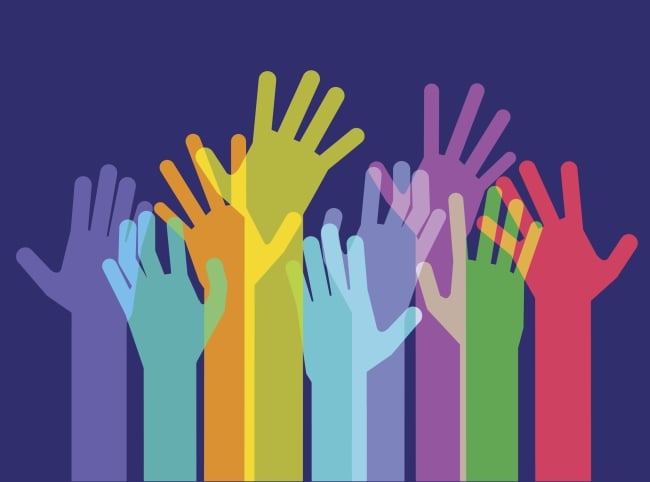You have /5 articles left.
Sign up for a free account or log in.

smartboy10/Digitalvision Vectors/Getty images
Colleges and universities often purport to pursue racial justice, diversity, equity and inclusion efforts, yet they offer few tools or strategies to support instructors in enacting truly transformative educational spaces. Within my university, I strive to position myself a teacher learner as well as a co-facilitator of opportunities for students from all backgrounds to engage with each other in reflection, critical inquiry and social action. One practice that I have found most helpful has been creating community agreements, which are aligned with an antiracist, anti-oppressive, decolonial feminist pedagogy that values relationality, mutual accountability and collective care.
I spend the first week of classes engaging students in such agreements in order to develop a set of values and practices to support our classroom dynamics. Our agreements reflect relational values and a practice of collective learning. Learning about our various ways of being, relating, connecting and interacting with each other and our environment helps us co-create, each quarter, what I call a critically compassionate learning community. A critically compassionate learning community is an inclusive, affirming and humanizing classroom learning experience.
Classroom community agreements can help cultivate critically compassionate student-student and student-teacher interactions because they provide a guide for how to reflect, relate and connect. They are also relationally or collaboratively determined, as well as context specific, so they can include a range of practices and embodiments intended to sustain a sense of belonging.
A key purpose of these agreements is to help foster the process of cultivating an ongoing learning community grounded the principle of in lak’ech. Ethnic studies educators, such as Patrick Roz Camangian and colleagues, and Cheryl E. Matias and Janiece Mackey, purport that culturally relevant pedagogy is a way of being in the world. Consequently, unlike rules that are enforced, agreements are not compulsory nor are students subjected to them. Our intentions, along with the practices that we seek to uphold with each other, characterize our classroom community agreements.
Another way to set the tone and culture of the learning space, and structure student-student and student-teacher interactions, is to establish classroom standards. Yet classroom standards can limit authentic relationship building and the cultivation of a sense of belonging or community of care among students and between students and educators. Like rules, the teachers often develop the standards with only limited, if any, student input. Classroom standards and ground rules are thus incorporated, institutionalized and reinforced in classrooms to shape the culture of the setting and power relationships, especially between students and teachers.
Nevertheless, as Glenn E. Singleton and Cyndie Hays underscore in “Beginning Courageous Conversations About Race,” we must engage with students in these critical dialogues. Both the culture and structure of the classroom, when informed by such standards or rules, has the potential to reify hierarchies of power, such as a teacher’s authority and influence over students. As described by Brian Arao and Kristi Clemens in “From Safe Spaces to Brave Spaces,” common examples of ground rules that are often associated with safe spaces presumed to be free of discomfort or disagreement may include the following: “agree to disagree,” “don’t take things personally,” “challenge by choice,” “respect others” and “no attacks.” Although ground rules can encourage student participation, they can also limit opportunities for critical dialogues on difficult, often uncomfortable topics for some students with positionalities of privilege and power or at the intersections of oppression. Talking about injustices and systemic issues is never easy.
Thus, we as the instructors should not frame or enforce the agreements, nor should they be standardized or instituted as the norm. On the contrary, we should develop them collaboratively with our students in each individual class. The agreements are not intended to be a set of expectations, but rather practices or intentions for how to engage with each other through critical dialogues. Because ground rules or classroom standards are often not formed with the intent to foster connection and relationality, a proposal to develop classroom community agreements can help encourage critically compassionate practices to support learning as a community building endeavor.
In the process of developing our agreements, I often ask students to imagine how they envision and wish their classroom interactions will be. Their reflections often include them sharing previous classroom experiences where they have felt seen, heard and understood by their peers, as well as the instructor. Other reflections have involved students underscoring the value of engaging in dialogues through class activities that build upon or support their engagement in assignments and group projects.
A key agreement that contributes to the process of purposeful engagement in student learning and fostering positive teacher-student relationships is a classroom community agreement of critical reflexivity, where students are attentive to their thoughts, why they are thinking what they are thinking and how that shows up in their classroom interactions and sharing. Indeed, while some students may describe this process as “critical reflexivity,” others may conceptualize it as an agreement founded upon a value of “embracing diversity,” “considering different standpoints” or “avoiding making assumptions.” All these labels can be understood as falling under the broad agreement of having students be introspective and intentional about what they share and why.
Instead of enforcing or expecting students to subscribe to a predetermined set of ground rules or classroom standards—often intended to prevent, defuse or minimize conflict, discomfort and tension—teachers must strive to cultivate practices grounded in ethical principles that recognize the humanity in all of us and our shared capacity to unlearn/relearn from a place of compassion, consciousness, and critical thinking.
As an educator, I encourage students to imagine what an affirming, humanizing classroom environment can and must be. With this invitation, we open ourselves to envisioning what we wish to experience in our learning community. How we want our learning experiences and relationships to be—what we will forge along the way—begins with our agreements. In other words, it begins by having students imagine what an affirming and inclusive humanizing classroom or learning environment is or can be. Then, they free write or journal a list or story about what such a momentarily utopic classroom space feels like. That imaginative exercise is then followed by small and larger group reflections and dialogues that culminate in generating a list of insights, common themes and working labels toward the development of our classroom community agreements.
I underscore to students that these agreements are constantly a work in progress, and that we can revise them as the quarter progress to meet each other and our needs wherever we may be at different points throughout the quarter. Of course, when disagreements arise, both while developing the agreements and throughout the quarter, we return to our anchoring principle of critical reflexivity that involves attending to our subjectivities to reconsider the root source of those disagreements, and whether consensus or compromise can be reached.
Closing Reflections
As an assistant professor at Santa Clara University, a private Jesuit liberal arts university in California, my pedagogy aligns with the mission of university, which includes a commitment to cura personalis, or care for the whole person. The university’s social justice, Jesuit mission toward serving communities on the margins distinguishes it from other institutions in the greater Bay Area. Its institutional culture reflects a teacher-scholar model that strives toward the development of the whole student person by cultivating citizen leaders of competence, consciousness and compassion.
I am a first-generation immigrant and college graduate with a Ph.D., a Chicana and a community-engaged researcher grounded in a decolonial feminist praxis, as well as the discipline of ethnic studies, which has its roots in student activism, community organizing and movements for justice. I bring my whole self into the classroom, and I welcome students to do the same.
The classroom community agreements that I’ve described, along with the process that facilitates their development and implementation, must be understood in relation to my positionalities. My lived experiences, together with my ethics, values and practices, guide my pedagogy. Thus, I approach education as a relational, embodied and experiential process of critical reflexivity in dialogue with others, especially with those who hold differing points of view. We must strive to foster a community of learners who are accountable and committed to mutual learning, as well as personal and collective growth.
How have the students reacted to the process of development classroom community agreements? I’ve encouraged them to write about their overall learning in the course and any concrete takeaways to apply and share with others. And as just one example, here’s what a cisgender female third-year student wrote about the agreements:
“We are all our own person, coming from our own different backgrounds, but that does not mean that we should treat others differently. As more and more of us begin to learn how to have conversations on difficult topics and reconnect, it is my hope that we can foster brave spaces that are also safe so that we can do better for ourselves and by others. I’m inspired to reflect on my own humanity, and identities to help me create spaces that are inclusive of all people.”
I’ve shared my thoughts and this quote to guide other educators in developing activities or strategies to support inclusive pedagogies. As instructors we must humble ourselves to consider what we can learn from spaces where critical thinking in solidarity and action can be fostered.
Classroom community agreements are an example of the possibility, through engagement and collaboration, to reimagine learning as a relationship. They can support educators in moving beyond the superficial or performative elements of safe and brave spaces toward cultivating authentic critically compassionate learning communities.








